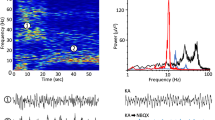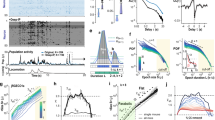Abstract
In the absence of external stimuli, the mammalian neocortex shows intrinsic network oscillations. These dynamics are characterized by translaminar assemblies of neurons whose activity synchronizes rhythmically in space and time. How different cortical layers influence the formation of these spontaneous cellular assemblies is poorly understood. We found that excitatory neurons in supragranular and infragranular layers have distinct roles in the regulation of intrinsic low-frequency oscillations in mice in vivo. Optogenetic activation of infragranular neurons generated network activity that resembled spontaneous events, whereas photoinhibition of these same neurons substantially attenuated slow ongoing dynamics. In contrast, light activation and inhibition of supragranular cells had modest effects on spontaneous slow activity. This study represents, to the best of our knowledge, the first causal demonstration that excitatory circuits located in distinct cortical layers differentially control spontaneous low-frequency dynamics.
This is a preview of subscription content, access via your institution
Access options
Subscribe to this journal
Receive 12 print issues and online access
$209.00 per year
only $17.42 per issue
Buy this article
- Purchase on Springer Link
- Instant access to full article PDF
Prices may be subject to local taxes which are calculated during checkout







Similar content being viewed by others
References
Jones, E.G. & Peters, A. Cerebral Cortex: Comparative Structure and Evolution of the Cerebral Cortex (Springer, New York, 1990).
Petersen, C.C. The functional organization of the barrel cortex. Neuron 56, 339–355 (2007).
Brecht, M. Barrel cortex and whisker-mediated behaviors. Curr. Opin. Neurobiol. 17, 408–416 (2007).
Brown, S.P. & Hestrin, S. Cell-type identity: a key to unlocking the function of neocortical circuits. Curr. Opin. Neurobiol. 19, 415–421 (2009).
Douglas, R.J. & Martin, K.A. Neuronal circuits of the neocortex. Annu. Rev. Neurosci. 27, 419–451 (2004).
Feldmeyer, D. Excitatory neuronal connectivity in the barrel cortex. Front Neuroanat. 6, 24 (2012).
Katz, L.C. & Shatz, C.J. Synaptic activity and the construction of cortical circuits. Science 274, 1133–1138 (1996).
Fiser, J., Chiu, C. & Weliky, M. Small modulation of ongoing cortical dynamics by sensory input during natural vision. Nature 431, 573–578 (2004).
Poulet, J.F. & Petersen, C.C. Internal brain state regulates membrane potential synchrony in barrel cortex of behaving mice. Nature 454, 881–885 (2008).
Destexhe, A. Intracellular and computational evidence for a dominant role of internal network activity in cortical computations. Curr. Opin. Neurobiol. 21, 717–725 (2011).
Petersen, C.C., Hahn, T.T., Mehta, M., Grinvald, A. & Sakmann, B. Interaction of sensory responses with spontaneous depolarization in layer 2/3 barrel cortex. Proc. Natl. Acad. Sci. USA 100, 13638–13643 (2003).
Sakata, S. & Harris, K.D. Laminar structure of spontaneous and sensory-evoked population activity in auditory cortex. Neuron 64, 404–418 (2009).
Luczak, A., Bartho, P. & Harris, K.D. Spontaneous events outline the realm of possible sensory responses in neocortical populations. Neuron 62, 413–425 (2009).
Steriade, M. Grouping of brain rhythms in corticothalamic systems. Neuroscience 137, 1087–1106 (2006).
Metherate, R., Cox, C.L. & Ashe, J.H. Cellular bases of neocortical activation: modulation of neural oscillations by the nucleus basalis and endogenous acetylcholine. J. Neurosci. 12, 4701–4711 (1992).
Steriade, M., Contreras, D., Dossi, R.C. & Nunez, A. The slow (less-than-1 Hz) oscillation in reticular thalamic and thalamocortical neurons - Scenario of sleep rhythm generation in interacting thalamic and neocortical networks. J. Neurosci. 13, 3284–3299 (1993).
Steriade, M., Nunez, A. & Amzica, F. Intracellular analysis of relations between the slow (less-than-1 Hz) neocortical oscillation and other sleep rhythms of the electroencephalogram. J. Neurosci. 13, 3266–3283 (1993).
Steriade, M., Nunez, A. & Amzica, F. A novel slow (less-than-1 Hz) oscillation of neocortical neurons in-vivo–depolarizing and hyperpolarizing components. J. Neurosci. 13, 3252–3265 (1993).
Luczak, A., Bartho, P., Marguet, S.L., Buzsaki, G. & Harris, K.D. Sequential structure of neocortical spontaneous activity in vivo. Proc. Natl. Acad. Sci. USA 104, 347–352 (2007).
Ji, D. & Wilson, M.A. Coordinated memory replay in the visual cortex and hippocampus during sleep. Nat. Neurosci. 10, 100–107 (2007).
Kerr, J.N., Greenberg, D. & Helmchen, F. Imaging input and output of neocortical networks in vivo. Proc. Natl. Acad. Sci. USA 102, 14063–14068 (2005).
Cossart, R., Aronov, D. & Yuste, R. Attractor dynamics of network UP states in the neocortex. Nature 423, 283–288 (2003).
Chauvette, S., Volgushev, M. & Timofeev, I. Origin of active states in local neocortical networks during slow sleep oscillation. Cereb. Cortex 20, 2660–2674 (2010).
Sanchez-Vives, M.V. & McCormick, D.A. Cellular and network mechanisms of rhythmic recurrent activity in neocortex. Nat. Neurosci. 3, 1027–1034 (2000).
Le Bon-Jego, M. & Yuste, R. Persistently active, pacemaker-like neurons in neocortex. Front Neurosci. 1, 123–129 (2007).
Nagel, G. et al. Channelrhodopsin-2, a directly light-gated cation-selective membrane channel. Proc. Natl. Acad. Sci. USA 100, 13940–13945 (2003).
Boyden, E.S., Zhang, F., Bamberg, E., Nagel, G. & Deisseroth, K. Millisecond-timescale, genetically targeted optical control of neural activity. Nat. Neurosci. 8, 1263–1268 (2005).
Contreras, D. Electrophysiological classes of neocortical neurons. Neural Netw. 17, 633–646 (2004).
Arenkiel, B.R. et al. In vivo light-induced activation of neural circuitry in transgenic mice expressing channelrhodopsin-2. Neuron 54, 205–218 (2007).
Sohal, V.S., Zhang, F., Yizhar, O. & Deisseroth, K. Parvalbumin neurons and gamma rhythms enhance cortical circuit performance. Nature 459, 698–702 (2009).
Petreanu, L., Huber, D., Sobczyk, A. & Svoboda, K. Channelrhodopsin-2-assisted circuit mapping of long-range callosal projections. Nat. Neurosci. 10, 663–668 (2007).
Adesnik, H. & Scanziani, M. Lateral competition for cortical space by layer-specific horizontal circuits. Nature 464, 1155–1160 (2010).
Lefort, S., Tomm, C., Floyd Sarria, J.C. & Petersen, C.C. The excitatory neuronal network of the C2 barrel column in mouse primary somatosensory cortex. Neuron 61, 301–316 (2009).
Chow, B.Y. et al. High-performance genetically targetable optical neural silencing by light-driven proton pumps. Nature 463, 98–102 (2010).
Gradinaru, V., Thompson, K.R. & Deisseroth, K. eNpHR: a Natronomonas halorhodopsin enhanced for optogenetic applications. Brain Cell Biol. 36, 129–139 (2008).
Chance, F.S., Abbott, L.F. & Reyes, A.D. Gain modulation from background synaptic input. Neuron 35, 773–782 (2002).
Frank, M.G., Issa, N.P. & Stryker, M.P. Sleep enhances plasticity in the developing visual cortex. Neuron 30, 275–287 (2001).
Jha, S.K. et al. Sleep-dependent plasticity requires cortical activity. J. Neurosci. 25, 9266–9274 (2005).
Vyazovskiy, V.V., Cirelli, C., Pfister-Genskow, M., Faraguna, U. & Tononi, G. Molecular and electrophysiological evidence for net synaptic potentiation in wake and depression in sleep. Nat. Neurosci. 11, 200–208 (2008).
Marshall, L., Helgadottir, H., Molle, M. & Born, J. Boosting slow oscillations during sleep potentiates memory. Nature 444, 610–613 (2006).
Contreras, D. & Steriade, M. Cellular basis of EEG slow rhythms: a study of dynamic corticothalamic relationships. J. Neurosci. 15, 604–622 (1995).
MacLean, J.N., Watson, B.O., Aaron, G.B. & Yuste, R. Internal dynamics determine the cortical response to thalamic stimulation. Neuron 48, 811–823 (2005).
Kirov, R., Weiss, C., Siebner, H.R., Born, J. & Marshall, L. Slow oscillation electrical brain stimulation during waking promotes EEG theta activity and memory encoding. Proc. Natl. Acad. Sci. USA 106, 15460–15465 (2009).
Massimini, M. et al. Triggering sleep slow waves by transcranial magnetic stimulation. Proc. Natl. Acad. Sci. USA 104, 8496–8501 (2007).
Papagiakoumou, E. et al. Scanless two-photon excitation of channelrhodopsin-2. Nat. Methods 7, 848–854 (2010).
Dal Maschio, M. et al. Simultaneous two-photon imaging and photo-stimulation with structured light illumination. Opt. Express 18, 18720–18731 (2010).
Meyer, H.S. et al. Number and laminar distribution of neurons in a thalamocortical projection column of rat vibrissal cortex. Cereb. Cortex 20, 2277–2286 (2010).
Amzica, F. & Steriade, M. Cellular substrates and laminar profile of sleep K-complex. Neuroscience 82, 671–686 (1997).
Wester, J.C. & Contreras, D. Columnar interactions determine horizontal propagation of recurrent network activity in neocortex. J. Neurosci. 32, 5454–5471 (2012).
Olsen, S.R., Bortone, D.S., Adesnik, H. & Scanziani, M. Gain control by layer six in cortical circuits of vision. Nature 483, 47–52 (2012).
Clovis, Y.M., Enard, W., Marinaro, F., Huttner, W.B. & De Pietri, T.D. Convergent repression of Foxp2 3′UTR by miR-9 and miR-132 in embryonic mouse neocortex: implications for radial migration of neurons. Development 139, 3332–3342 (2012).
Han, X. et al. A high-light sensitivity optical neural silencer: development and application to optogenetic control of non-human primate cortex. Front Syst. Neurosci. 5, 18 (2011).
Cardin, J.A. et al. Targeted optogenetic stimulation and recording of neurons in vivo using cell-type-specific expression of Channelrhodopsin-2. Nat. Protoc. 5, 247–254 (2010).
Fellin, T. et al. Endogenous nonneuronal modulators of synaptic transmission control cortical slow oscillations in vivo. Proc. Natl. Acad. Sci. USA 106, 15037–15042 (2009).
Margrie, T.W., Brecht, M. & Sakmann, B. In vivo, low-resistance, whole-cell recordings from neurons in the anaesthetized and awake mammalian brain. Pflugers Archiv-European Journal of Physiology 444, 491–498 (2002).
Fellin, T. et al. Neuronal synchrony mediated by astrocytic glutamate through activation of extrasynaptic NMDA receptors. Neuron 43, 729–743 (2004).
Halassa, M.M. et al. Astrocytic modulation of sleep homeostasis and cognitive consequences of sleep loss. Neuron 61, 213–219 (2009).
Acknowledgements
We thank J. Assad, A. Bacci, F. Benfenati, A. Blau and G. Carmignoto for critical reading and helpful comments on the manuscript. We thank C. Gerfen (US National Institute of Mental Health) for Rbp4-cre mice, K. Deisseroth (Stanford University) for pAAV-EF1a.DIO.hChR2(H134R)-EYFP.WPRE.hGH (Addgene 20298), pAAV-EF1.dflox.hChR2(H134R)-mCherry.WPRE.hGH (Addgene 20297) and pAAV-EF1a.DIO.eNpHR-eYFP.WP.hGH (Addgene 20949), K. Svoboda (Howard Hughes Medical Institute, Janelia Farm) for pCAGGS-ChR2-Venus (Addgene 15753), E. Boyden (Massachusetts Institute of Technology) for pAAV-CAG-ArchT-GFP (Addgene 29777), FCK-Arch-GFP (Addgene 22217) and AAV2/1.flex.CBA.Arch-GFP.WPRE.SV40 (Addgene 22222) and S. Guazzi for subcloning and amplification of some of the plasmids used in this study. This work was supported by the Italian Institute of Technology and grants from San Paolo “Programma in Neuroscienze”, MIUR FIRB (RBAP11X42L) and Telethon-Italy (GGP10138) to T.F.
Author information
Authors and Affiliations
Contributions
R.B., G.D., M.D.M., P.F. and T.F. performed all experiments and analysis presented in this manuscript. S.B. and T.F. performed viral injections. Y.C. performed initial in utero electroporation experiments. R.B., Y.C., D.D.P.T. and T.F. designed in utero electroporation experiments. G.L. and V.T. provided assistance with EEG recordings on behaving animals. D.D.P.T. provided reagents. T.F. conceived and coordinated the project. T.F. wrote the paper. All authors approved the final version of the manuscript.
Corresponding author
Ethics declarations
Competing interests
The authors declare no competing financial interests.
Supplementary information
Supplementary Text and Figures
Supplementary Figures 1–14 (PDF 3567 kb)
Rights and permissions
About this article
Cite this article
Beltramo, R., D'Urso, G., Dal Maschio, M. et al. Layer-specific excitatory circuits differentially control recurrent network dynamics in the neocortex. Nat Neurosci 16, 227–234 (2013). https://doi.org/10.1038/nn.3306
Received:
Accepted:
Published:
Issue Date:
DOI: https://doi.org/10.1038/nn.3306
This article is cited by
-
Translaminar recurrence from layer 5 suppresses superficial cortical layers
Nature Communications (2022)
-
A role for the cortex in sleep–wake regulation
Nature Neuroscience (2021)
-
Reply to: Questions about the role of P3HT nanoparticles in retinal stimulation
Nature Nanotechnology (2021)
-
Rapid fast-delta decay following prolonged wakefulness marks a phase of wake-inertia in NREM sleep
Nature Communications (2020)
-
Sleepers track informative speech in a multitalker environment
Nature Human Behaviour (2019)



